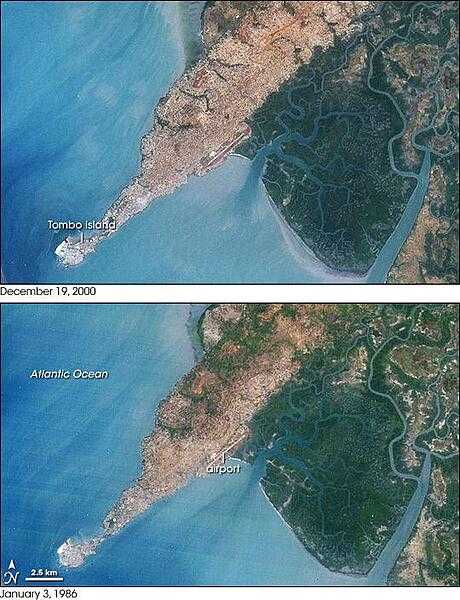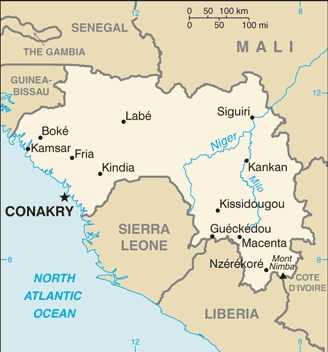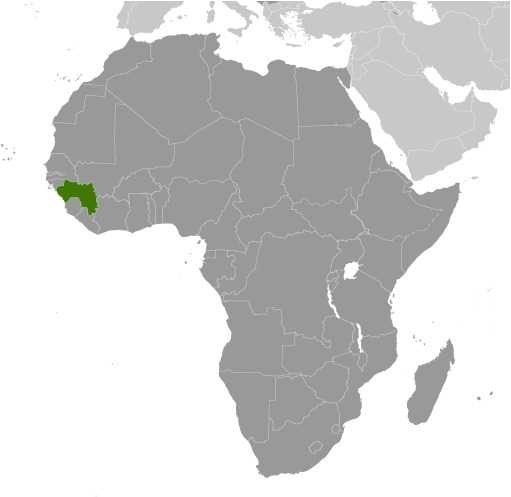Introduction
Background
Guinea's deep Muslim heritage arrived via the neighboring Almoravid Empire in the 11th century. Following Almoravid decline, Guinea existed on the fringe of several African kingdoms, all competing for regional dominance. In the 13th century, the Mali Empire took control of Guinea and encouraged its already growing Muslim faith. After the fall of the West African empires, various smaller kingdoms controlled Guinea. In the 18th century, Fulani Muslims established an Islamic state in central Guinea that provided one of the earliest examples of a written constitution and alternating leadership. European traders first arrived in the 16th century, and the French secured colonial rule in the 19th century.
In 1958, Guinea achieved independence from France. Sekou TOURE became Guinea’s first post-independence president; he established a dictatorial regime and ruled until his death in 1984, after which General Lansana CONTE staged a coup and seized the government. He too established an authoritarian regime and manipulated presidential elections until his death in 2008, when Captain Moussa Dadis CAMARA led a military coup, seized power, and suspended the constitution. In 2009, CAMARA was wounded in an assassination attempt and was exiled to Burkina Faso. In 2010 and 2013 respectively, the country held its first free and fair presidential and legislative elections. Alpha CONDE won the 2010 and 2015 presidential elections, and his first cabinet was the first all-civilian government in Guinean history. CONDE won a third term in 2020 after a constitutional change to term limits. In 2021, Col Mamady DOUMBOUYA led another successful military coup, establishing the National Committee for Reconciliation and Development (CNRD), suspending the constitution, and dissolving the government and the legislature. DOUMBOUYA was sworn in as transition president and appointed Mohamed BEAVOGUI as transition prime minister. The National Transition Council (CNT), which acts as the legislative body for the transition, was formed in 2022 and consists of appointed members representing a broad swath of Guinean society.
Visit the Definitions and Notes page to view a description of each topic.
Geography
Location
Western Africa, bordering the North Atlantic Ocean, between Guinea-Bissau and Sierra Leone
Geographic coordinates
11 00 N, 10 00 W
Map references
Africa
Area - comparative
slightly smaller than Oregon; slightly larger than twice the size of Pennsylvania
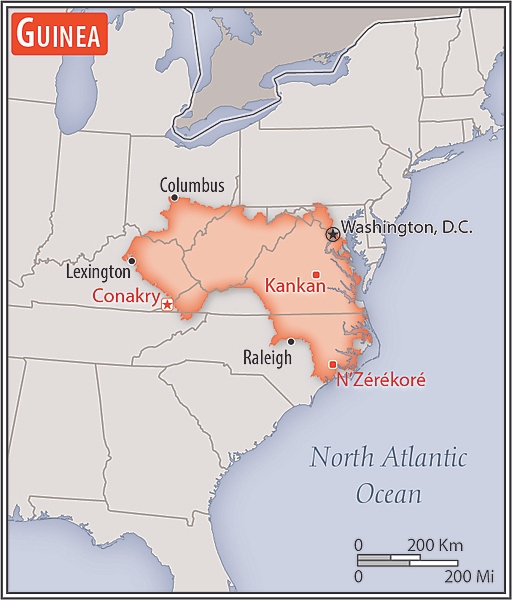
Land boundaries
total: 4,046 km
border countries (6): Cote d'Ivoire 816 km; Guinea-Bissau 421 km; Liberia 590 km; Mali 1062 km; Senegal 363 km; Sierra Leone 794 km
Coastline
320 km
Maritime claims
territorial sea: 12 nm
exclusive economic zone: 200 nm
Climate
generally hot and humid; monsoonal-type rainy season (June to November) with southwesterly winds; dry season (December to May) with northeasterly harmattan winds
Terrain
generally flat coastal plain, hilly to mountainous interior
Elevation
highest point: Mont Nimba 1,752 m
lowest point: Atlantic Ocean 0 m
mean elevation: 472 m
Natural resources
bauxite, iron ore, diamonds, gold, uranium, hydropower, fish, salt
Land use
agricultural land: 58.1% (2018 est.)
arable land: 11.8% (2018 est.)
permanent crops: 2.8% (2018 est.)
permanent pasture: 43.5% (2018 est.)
forest: 26.5% (2018 est.)
other: 15.4% (2018 est.)
Irrigated land
950 sq km (2012)
Major rivers (by length in km)
Niger river source (shared with Mali, and Nigeria [m]) - 4,200 km; Gambie (Gambia) river source (shared with Senegal and The Gambia [m]) - 1,094 km
note – [s] after country name indicates river source; [m] after country name indicates river mouth
Major watersheds (area sq km)
Atlantic Ocean drainage: Niger (2,261,741 sq km), Senegal (456,397 sq km)
Population distribution
areas of highest density are in the west and south; interior is sparsely populated as shown in this population distribution map
Natural hazards
hot, dry, dusty harmattan haze may reduce visibility during dry season
Geography - note
the Niger and its important tributary the Milo River have their sources in the Guinean highlands
People and Society
Population
total: 13,986,179
male: 6,985,606
female: 7,000,573 (2024 est.)
comparison rankings: female 75; male 75; total 75
Nationality
noun: Guinean(s)
adjective: Guinean
Ethnic groups
Fulani (Peuhl) 33.4%, Malinke 29.4%, Susu 21.2%, Guerze 7.8%, Kissi 6.2%, Toma 1.6%, other/foreign 0.4% (2018 est.)
Languages
French (official), Pular, Maninka, Susu, other native languages
note: about 40 languages are spoken; each ethnic group has its own language
Religions
Muslim 85.2%, Christian 13.4%, animist 0.2%, none 1.2% (2018 est.)
Demographic profile
Guinea’s strong population growth is a result of declining mortality rates and sustained elevated fertility. The population growth rate was somewhat tempered in the 2000s because of a period of net outmigration. Although life expectancy and mortality rates have improved over the last two decades, the nearly universal practice of female genital cutting continues to contribute to high infant and maternal mortality rates. Guinea’s total fertility remains high at about 5 children per woman as of 2022 because of the ongoing preference for larger families, low contraceptive usage and availability, a lack of educational attainment and empowerment among women, and poverty. A lack of literacy and vocational training programs limit job prospects for youths, but even those with university degrees often have no option but to work in the informal sector. About 60% of the country’s large youth population is unemployed.
Tensions and refugees have spilled over Guinea’s borders with Sierra Leone, Liberia, and Cote d’Ivoire. During the 1990s Guinea harbored as many as half a million refugees from Sierra Leone and Liberia, more refugees than any other African country for much of that decade. About half sought refuge in the volatile "Parrot’s Beak" region of southwest Guinea, a wedge of land jutting into Sierra Leone near the Liberian border. Many were relocated within Guinea in the early 2000s because the area suffered repeated cross-border attacks from various government and rebel forces, as well as anti-refugee violence.
Age structure
0-14 years: 40.9% (male 2,884,146/female 2,835,794)
15-64 years: 55.1% (male 3,846,852/female 3,856,366)
65 years and over: 4% (2024 est.) (male 254,608/female 308,413)
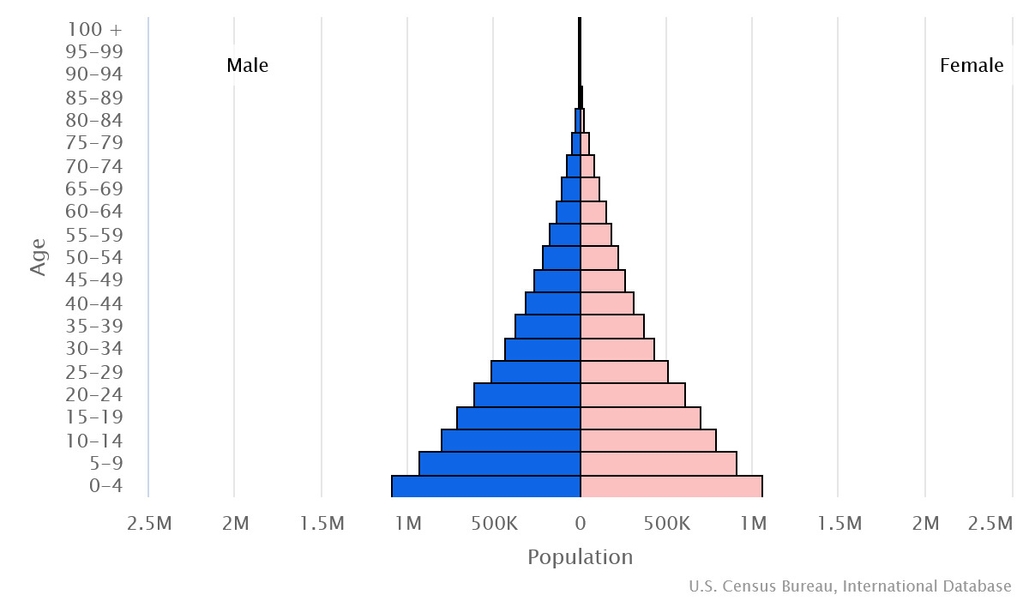
Dependency ratios
total dependency ratio: 82.4
youth dependency ratio: 76.3
elderly dependency ratio: 6.1
potential support ratio: 16.3 (2021 est.)
Median age
total: 19.4 years (2024 est.)
male: 19.2 years
female: 19.6 years
comparison ranking: total 209
Population distribution
areas of highest density are in the west and south; interior is sparsely populated as shown in this population distribution map
Urbanization
urban population: 38.1% of total population (2023)
rate of urbanization: 3.64% annual rate of change (2020-25 est.)
Major urban areas - population
2.111 million CONAKRY (capital) (2023)
Sex ratio
at birth: 1.03 male(s)/female
0-14 years: 1.02 male(s)/female
15-64 years: 1 male(s)/female
65 years and over: 0.83 male(s)/female
total population: 1 male(s)/female (2024 est.)
Mother's mean age at first birth
19.9 years (2018 est.)
note: data represents median age at first birth among women 20-49
Infant mortality rate
total: 47 deaths/1,000 live births (2024 est.)
male: 51.6 deaths/1,000 live births
female: 42.3 deaths/1,000 live births
comparison ranking: total 21
Life expectancy at birth
total population: 64.6 years (2024 est.)
male: 62.7 years
female: 66.6 years
comparison ranking: total population 206
Gross reproduction rate
2.36 (2024 est.)
Contraceptive prevalence rate
10.9% (2018)
Drinking water source
improved: urban: 99.5% of population
rural: 76.9% of population
total: 85.2% of population
unimproved: urban: 0.5% of population
rural: 23.1% of population
total: 14.8% of population (2020 est.)
Current health expenditure
4% of GDP (2020)
Physician density
0.23 physicians/1,000 population (2018)
Hospital bed density
0.3 beds/1,000 population (2011)
Sanitation facility access
improved: urban: 90.9% of population
rural: 38.7% of population
total: 58% of population
unimproved: urban: 9.1% of population
rural: 61.3% of population
total: 42% of population (2020 est.)
Major infectious diseases
degree of risk: very high (2023)
food or waterborne diseases: bacterial and protozoal diarrhea, hepatitis A, and typhoid fever
vectorborne diseases: malaria, dengue fever, and sexually transmitted diseases: hepatitis B (2024)
water contact diseases: schistosomiasis
animal contact diseases: rabies
aerosolized dust or soil contact diseases: Lassa fever
note: on 20 September 2023, the Centers for Disease Control and Prevention updated a Travel Health Alert for a diphtheria outbreak in several states in Guinea; vaccination against diphtheria is essential to protect against disease; if you are traveling to an affected area, you should be up to date with your diphtheria vaccines; before travel, discuss the need for a booster dose with your healthcare professional; diphtheria is a serious infection caused by strains of Corynebacterium diphtheriae bacteria that make a toxin from which people get very sick; diphtheria bacteria spread from person to person through respiratory droplets like from coughing or sneezing; people can also get sick from touching open sores or ulcers of people sick with diphtheria (see attached map)
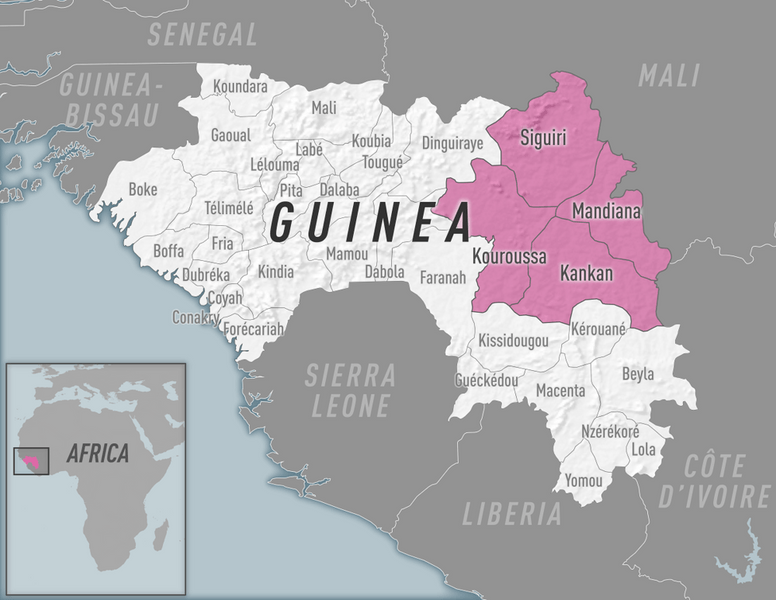
Alcohol consumption per capita
total: 0.33 liters of pure alcohol (2019 est.)
beer: 0.29 liters of pure alcohol (2019 est.)
wine: 0.01 liters of pure alcohol (2019 est.)
spirits: 0.03 liters of pure alcohol (2019 est.)
other alcohols: 0 liters of pure alcohol (2019 est.)
comparison ranking: total 168
Currently married women (ages 15-49)
68.7% (2023 est.)
Child marriage
women married by age 15: 17%
women married by age 18: 46.5%
men married by age 18: 1.9% (2018 est.)
Literacy
definition: age 15 and over can read and write
total population: 45.3%
male: 61.2%
female: 31.3% (2021)
School life expectancy (primary to tertiary education)
total: 9 years
male: 10 years
female: 8 years (2014)
Environment
Environment - current issues
deforestation; inadequate potable water; desertification; soil contamination and erosion; overfishing, overpopulation in forest region; poor mining practices lead to environmental damage; water pollution; improper waste disposal
Environment - international agreements
party to: Biodiversity, Climate Change, Climate Change-Kyoto Protocol, Climate Change-Paris Agreement, Comprehensive Nuclear Test Ban, Desertification, Endangered Species, Hazardous Wastes, Law of the Sea, Ozone Layer Protection, Ship Pollution, Wetlands, Whaling
signed, but not ratified: none of the selected agreements
Climate
generally hot and humid; monsoonal-type rainy season (June to November) with southwesterly winds; dry season (December to May) with northeasterly harmattan winds
Land use
agricultural land: 58.1% (2018 est.)
arable land: 11.8% (2018 est.)
permanent crops: 2.8% (2018 est.)
permanent pasture: 43.5% (2018 est.)
forest: 26.5% (2018 est.)
other: 15.4% (2018 est.)
Urbanization
urban population: 38.1% of total population (2023)
rate of urbanization: 3.64% annual rate of change (2020-25 est.)
Food insecurity
severe localized food insecurity: due to reduced incomes - about 1.22 million people are projected to be in need of food assistance between June and August 2022, primarily due to food access constraints on account of the economic effects of the COVID-19 pandemic (2022)
Air pollutants
particulate matter emissions: 37.57 micrograms per cubic meter (2019 est.)
carbon dioxide emissions: 3 megatons (2016 est.)
methane emissions: 11.13 megatons (2020 est.)
Waste and recycling
municipal solid waste generated annually: 596,911 tons (1996 est.)
municipal solid waste recycled annually: 29,846 tons (2005 est.)
percent of municipal solid waste recycled: 5% (2005 est.)
Major rivers (by length in km)
Niger river source (shared with Mali, and Nigeria [m]) - 4,200 km; Gambie (Gambia) river source (shared with Senegal and The Gambia [m]) - 1,094 km
note – [s] after country name indicates river source; [m] after country name indicates river mouth
Major watersheds (area sq km)
Atlantic Ocean drainage: Niger (2,261,741 sq km), Senegal (456,397 sq km)
Total water withdrawal
municipal: 230 million cubic meters (2020 est.)
industrial: 60 million cubic meters (2020 est.)
agricultural: 600 million cubic meters (2020 est.)
Total renewable water resources
226 billion cubic meters (2020 est.)
Government
Country name
conventional long form: Republic of Guinea
conventional short form: Guinea
local long form: Republique de Guinee
local short form: Guinee
former: French Guinea
etymology: the country is named after the Guinea region of West Africa that lies along the Gulf of Guinea and stretches north to the Sahel
Government type
presidential republic
Capital
name: Conakry
geographic coordinates: 9 30 N, 13 42 W
time difference: UTC 0 (5 hours ahead of Washington, DC, during Standard Time)
etymology: according to tradition, the name derives from the fusion of the name Cona, a Baga wine and cheese producer who lived on Tombo Island (the original site of the present-day capital), and the word nakiri, which in Susu means "the other bank" or "the other side"; supposedly, Baga's palm grove produced the best wine on the island and people traveling to sample his vintage, would say: "I am going to Cona, on the other bank (Cona-nakiri)," which over time became Conakry
Administrative divisions
7 regions administrative (administrative regions) and 1 gouvenorat (governorate)*; Boke, Conakry*, Faranah, Kankan, Kindia, Labe, Mamou, N'Zerekore
Independence
2 October 1958 (from France)
National holiday
Independence Day, 2 October (1958)
Constitution
history: previous 1958, 1990; 2010 and a referendum in 2020, which was suspended on 5 September 2021 via a coup d’etat; on 27 September, the Transitional Charter was released, which supersedes the constitution until a new constitution is promulgated
amendments: proposed by the National Assembly or by the president of the republic; consideration of proposals requires approval by simple majority vote by the Assembly; passage requires approval in referendum; the president can opt to submit amendments directly to the Assembly, in which case approval requires at least two-thirds majority vote; revised in 2020
Legal system
civil law system based on the French model
International law organization participation
accepts compulsory ICJ jurisdiction with reservations; accepts ICCt jurisdiction
Citizenship
citizenship by birth: no
citizenship by descent only: at least one parent must be a citizen of Guinea
dual citizenship recognized: no
residency requirement for naturalization: na
Suffrage
18 years of age; universal
Executive branch
chief of state: President Col. Mamady DOUMBOUYA (since 1 October 2021)
head of government: Prime Minister Mamadou Oury BAH (since 27 February 2024)
cabinet: formerly the Council of Ministers appointed by the president; note - on 5 September 2021, the military arrested and detained the president, suspended the constitution, and dissolved the government and legislature
elections/appointments: formerly, the president was directly elected by absolute majority popular vote in 2 rounds if needed for a 5-year term (eligible for a second term) and the prime minister appointed by the president; election last held on 18 October 2020; note - a new election timetable has not been announced by the transitional government; note - on 5 September 2021, Col. Mamady DOUMBOUYA led a military coup in which President CONDE was arrested and detained, the constitution suspended, and the government and People's National Assembly dissolved; on 1 October 2021, DOUMBOUYA was sworn in as transitional president
election results:
2020: Alpha CONDE reelected president in the first round; percent of vote - Alpha CONDE (RPG) 59.5%, Cellou Dalein DIALLO (UFDG) 33.5%, other 7%
2015: Alpha CONDE reelected president in the first round; percent of vote - Alpha CONDE (RPG) 57.8%, Cellou Dalein DIALLO (UFDG) 31.4%, other 10.8%
Legislative branch
description: formerly the People's National Assembly; note - on 5 September 2021, Col. Mamady DOUMBOUYA led a military coup in which President CONDE was arrested and detained, the constitution suspended, and the government and People's National Assembly dissolved; on 22 January 2022, an 81-member Transitional National Council was installed; on 19 February 2024 Guinea's military leaders dissolved the government
elections: 81 members to the Transitional National Council were appointed by the transitional president Col. Mamady DOUMBOUYA on 22 January 2022; elections for a permanent legislature had not been announced as of late January 2022; on 19 February 2024 Guinea's military leaders dissolved the government
election results: 81 members of the National Transitional Council appointed on 22 January 2022 by the transitional president; the members represent all of the country's socio-professional organizations and political parties
Judicial branch
highest court(s): Supreme Court or Cour Supreme (organized into Administrative Chamber and Civil, Penal, and Social Chamber; court consists of the first president, 2 chamber presidents, 10 councilors, the solicitor general, and NA deputies); Constitutional Court - suspended on 5 September 2021
judge selection and term of office: Supreme Court first president appointed by the national president after consultation with the National Assembly; other members appointed by presidential decree; members serve 9-year terms until age 65
subordinate courts: Court of Appeal or Cour d'Appel; High Court of Justice or Cour d'Assises; Court of Account (Court of Auditors); Courts of First Instance (Tribunal de Premiere Instance); labor court; military tribunal; justices of the peace; specialized courts
Political parties and leaders
African Congress for Democracy and Renewal or CADRE [Daniel KOLIE]
Alliance for National Renewal or ARN [Pepe Koulemou KOULEMOU]
Alliance for National Renewal or ARENA [Sekou Koureissy CONDE]
Bloc Liberal or BL [Faya MILLIMONO]
Citizen Generation or GECI [Mohamed SOUMAH]
Citizen Party for the Defense of Collective Interests or PCDIC [Hamidou BARRY]
Democratic Alliance for Renewal or ADR [Alpha Oumar Taran DIALLO]
Democratic National Movement or MND [Ousmane DORE]
Democratic Union for Renewal and Progress or UDRP [Edouard Zoutomou KPOGHOMOU]
Democratic Union of Guinea or UDG [Mamadou SYLLA]
Democratic People's Movement of Guinea or MPDG [Siaka BARRY]
Democratic Workers' Party of Guinea or PDTG [Talibi Dos CAMARA]
Front for the National Alliance or FAN [Makale CAMARA]
Generation for Reconciliation Union and Prosperity or GRUP [Papa Koly KOUROUMA]
Guinea for Democracy and Balance or GDE [Aboubacar SOUMAH]
Guinean Party for Peaceful Coexistence and Development or PGCD [Nene Moussa Maleya CAMARA]
Guinean Party for Solidarity and Democracy or PGSD [Elie KAMANO]
Guinean Union for Democracy and Development or UGDD [Francis HABA]
Guinean Rally for Development or RGD [Abdoul Kabele CAMARA]
Guinean Rally for Unity and Development or RGUD [Abraham BOURE]
Guinean Renaissance Party or PGR [Ibrahima Sory CONDE]
Modern Guinea [Thierno Yaya DIALLO]
Movement for Solidarity and Development or MSD [Abdoulaye DIALLO]
National Committee for Reconciliation and Development [Colonel Mamady DOUMBOUYA]
National Front for Development or FND [Alhousseine Makanera KAKE]
National Union for Prosperity or UNP [Alpha Mady SOUMAH]
National Party for Hope and Development or PEDN [Lansana KOUYATE]
New Democratic Forces or NFD [Mouctar DIALLO]
New Generation for the Republic or NGR [Abbe SYLLA]
New Guinea or NG [Mohamed CISSE]
New Political Generation or NGP [Badra KONE]
Party for Progress and Change or PPC [Aboubacar Biro SOUMAH]
Party of Citizen Action through Labor or PACT [Makale TRAORE]
Party of Democrats for Hope or PADES [Ousmane KABA]
Party of Freedom and Progress or PLP [Laye Souleymane DIALLO]
Party of Hope for National Development or PEDN [Lansana KOUYATE]
Rally for Renaissance and Development or RRD [Abdoulaye KOUROUMA]
Rally for the Guinean People or RPG (vacant)
Rally for the Integrated Development of Guinea or RDIG [Jean Marc TELIANO]
Rally for the Republic or RPR [Diabaty DORE]
Union for Progress and Renewal or UPR [Ousmane BAH]
Union for the Defense of Republican Interests or UDIR [Bouya KONATE]
Union for the Progress of Guinea or UPG [Jacques GBONIMY]
Union of Democratic Forces or UFD [Mamadou Baadiko BAH]
Union of Democratic Forces of Guinea or UFDG [Cellou Dalein DIALLO]
Union of Democrats for the Renaissance of Guinea or UDRG [Amadou Oury BAH]
Union of Republican Forces or UFR [Sidya TOURE]
Unity and Progress Party or PUP [Fode BANGOURA]
International organization participation
ACP, AfDB, EITI (compliant country), FAO, G-77, IBRD, ICAO, ICCt, ICRM, IDA, IDB, IFAD, IFC, IFRCS, ILO, IMF, IMO, Interpol, IOC, IOM, IPU, ISO (correspondent), ITSO, ITU, ITUC (NGOs), MIGA, MINURSO, MONUSCO, NAM, OIC, OIF, OPCW, UN, UNCTAD, UNESCO, UNHCR, UNIDO, UNISFA, UNMISS, UNOCI, UNWTO, UPU, WCO, WFTU (NGOs), WHO, WIPO, WMO, WTO
Diplomatic representation in the US
chief of mission: Ambassador Fatoumata KABA (since 19 April 2023)
chancery: 2112 Leroy Place NW, Washington, DC 20008
telephone: [1] (202) 986-4300
FAX: [1] (202) 986-3800
email address and website:
http://guineaembassyusa.org/en/welcome-to-the-embassy-of-guinea-washington-usa/
consulate(s): Los Angelos
Diplomatic representation from the US
chief of mission: Ambassador Troy Damian FITRELL (since January 2022)
embassy: Transversale No. 2, Centre Administratif de Koloma, Commune de Ratoma, Conakry
mailing address: 2110 Conakry Place, Washington DC 20521-2110
telephone: [224] 65-10-40-00
FAX: [224] 65-10-42-97
email address and website:
ConakryACS@state.gov
https://gn.usembassy.gov/
Flag description
three equal vertical bands of red (hoist side), yellow, and green; red represents the people's sacrifice for liberation and work; yellow stands for the sun, for the riches of the earth, and for justice; green symbolizes the country's vegetation and unity
note: uses the popular Pan-African colors of Ethiopia; the colors from left to right are the reverse of those on the flags of neighboring Mali and Senegal
National symbol(s)
elephant; national colors: red, yellow, green
National anthem
name: "Liberte" (Liberty)
lyrics/music: unknown/Fodeba KEITA
note: adopted 1958
National heritage
total World Heritage Sites: 1 (natural)
selected World Heritage Site locales: Mount Nimba Strict Nature Reserve
Economy
Economic overview
growing but primarily agrarian West African economy; major mining sector; improving fiscal and debt balances prior to COVID-19; economy increasingly vulnerable to climate change; slow infrastructure improvements; gender wealth and human capital gaps
Real GDP (purchasing power parity)
$56.655 billion (2023 est.)
$52.918 billion (2022 est.)
$50.543 billion (2021 est.)
note: data in 2021 dollars
comparison ranking: 120
Real GDP growth rate
7.06% (2023 est.)
4.7% (2022 est.)
3.9% (2021 est.)
note: annual GDP % growth based on constant local currency
comparison ranking: 20
Real GDP per capita
$4,000 (2023 est.)
$3,800 (2022 est.)
$3,700 (2021 est.)
note: data in 2021 dollars
comparison ranking: 187
GDP (official exchange rate)
$23.612 billion (2023 est.)
note: data in current dollars at official exchange rate
Inflation rate (consumer prices)
7.8% (2023 est.)
10.49% (2022 est.)
12.6% (2021 est.)
note: annual % change based on consumer prices
comparison ranking: 152
GDP - composition, by sector of origin
agriculture: 19.8% (2017 est.)
industry: 32.1% (2017 est.)
services: 48.1% (2017 est.)
comparison rankings: services 188; industry 67; agriculture 50
GDP - composition, by end use
household consumption: 80.8% (2017 est.)
government consumption: 6.6% (2017 est.)
investment in fixed capital: 9.1% (2017 est.)
investment in inventories: 18.5% (2017 est.)
exports of goods and services: 21.9% (2017 est.)
imports of goods and services: -36.9% (2017 est.)
Agricultural products
cassava, rice, groundnuts, oil palm fruit, maize, fonio, plantains, potatoes, sweet potatoes, yams (2022)
note: top ten agricultural products based on tonnage
Industries
bauxite, gold, diamonds, iron ore; light manufacturing, agricultural processing
Industrial production growth rate
11.47% (2023 est.)
note: annual % change in industrial value added based on constant local currency
comparison ranking: 11
Labor force
4.401 million (2023 est.)
note: number of people ages 15 or older who are employed or seeking work
comparison ranking: 96
Unemployment rate
5.3% (2023 est.)
5.33% (2022 est.)
5.77% (2021 est.)
note: % of labor force seeking employment
comparison ranking: 105
Youth unemployment rate (ages 15-24)
total: 8.2% (2021 est.)
male: 7%
female: 9.2%
comparison ranking: total 167
Population below poverty line
43.7% (2018 est.)
note: % of population with income below national poverty line
Gini Index coefficient - distribution of family income
29.6 (2018 est.)
note: index (0-100) of income distribution; higher values represent greater inequality
comparison ranking: 149
Household income or consumption by percentage share
lowest 10%: 3.5% (2018 est.)
highest 10%: 23.1% (2018 est.)
note: % share of income accruing to lowest and highest 10% of population
Remittances
2.36% of GDP (2023 est.)
2.51% of GDP (2022 est.)
2.14% of GDP (2021 est.)
note: personal transfers and compensation between resident and non-resident individuals/households/entities
Budget
revenues: $1.949 billion (2019 est.)
expenditures: $2.014 billion (2019 est.)
Current account balance
$3.35 billion (2022 est.)
$4.639 billion (2021 est.)
$2.685 billion (2020 est.)
note: balance of payments - net trade and primary/secondary income in current dollars
comparison ranking: 40
Exports
$8.898 billion (2022 est.)
$10.266 billion (2021 est.)
$8.996 billion (2020 est.)
note: balance of payments - exports of goods and services in current dollars
comparison ranking: 120
Exports - partners
China 37%, India 27%, UAE 25%, Switzerland 3%, Spain 2% (2022)
note: top five export partners based on percentage share of exports
Exports - commodities
gold, aluminum ore, coconuts/Brazil nuts/cashews, cocoa beans, fish (2022)
note: top five export commodities based on value in dollars
Imports
$5.749 billion (2022 est.)
$5.353 billion (2021 est.)
$6.314 billion (2020 est.)
note: balance of payments - imports of goods and services in current dollars
comparison ranking: 146
Imports - partners
China 37%, India 10%, Netherlands 8%, UAE 4%, Belgium 4% (2022)
note: top five import partners based on percentage share of imports
Imports - commodities
refined petroleum, rice, garments, plastic products, wheat (2022)
note: top five import commodities based on value in dollars
Reserves of foreign exchange and gold
$1.499 billion (2020 est.)
$1.379 billion (2019 est.)
$1.242 billion (2018 est.)
note: holdings of gold (year-end prices)/foreign exchange/special drawing rights in current dollars
comparison ranking: 128
Debt - external
$1.458 billion (31 December 2017 est.)
$1.462 billion (31 December 2016 est.)
comparison ranking: 160
Exchange rates
Guinean francs (GNF) per US dollar -
Exchange rates:
9,565.082 (2020 est.)
9,183.876 (2019 est.)
9,011.134 (2018 est.)
9,088.319 (2017 est.)
8,967.927 (2016 est.)
Energy
Electricity access
electrification - total population: 47.7% (2022 est.)
electrification - urban areas: 91%
electrification - rural areas: 21.3%
Electricity
installed generating capacity: 1.191 million kW (2022 est.)
consumption: 2.625 billion kWh (2022 est.)
transmission/distribution losses: 418.8 million kWh (2022 est.)
comparison rankings: transmission/distribution losses 75; consumption 143; installed generating capacity 133
Electricity generation sources
fossil fuels: 33.6% of total installed capacity (2022 est.)
solar: 0.7% of total installed capacity (2022 est.)
hydroelectricity: 65.7% of total installed capacity (2022 est.)
Coal
imports: 2,000 metric tons (2022 est.)
Petroleum
refined petroleum consumption: 30,000 bbl/day (2022 est.)
Carbon dioxide emissions
4.502 million metric tonnes of CO2 (2022 est.)
from coal and metallurgical coke: 5,000 metric tonnes of CO2 (2022 est.)
from petroleum and other liquids: 4.497 million metric tonnes of CO2 (2022 est.)
comparison ranking: total emissions 137
Communications
Telephones - fixed lines
total subscriptions: 0 (2021 est.)
subscriptions per 100 inhabitants: (2021 est.) less than 1
comparison ranking: total subscriptions 222
Telephones - mobile cellular
total subscriptions: 13.795 million (2021 est.)
subscriptions per 100 inhabitants: 102 (2021 est.)
comparison ranking: total subscriptions 76
Telecommunication systems
general assessment: the number of mobile subscribers grew strongly while revenue also increased steadily; fixed broadband services are still very limited and expensive, though there have been some positive developments in recent years; the landing of the first international submarine cable in 2012, and the setting up of an IXP in mid-2013, increased the bandwidth available to the ISPs, and helped reduce the cost of internet services for end-users; a National Backbone Network was completed in mid-2020, connecting administrative centers across the country; almost all internet connections are made via mobile networks; GSM services account for a dwindling proportion of connections, in line with the greater reach of services based on 3G and LTE (2022)
domestic: fixed-line teledensity is less than 1 per 100 persons; mobile-cellular subscribership is just over 105 per 100 persons (2020)
international: country code - 224; ACE submarine cable connecting Guinea with 20 landing points in Western and South Africa and Europe; satellite earth station - 1 Intelsat (Atlantic Ocean (2019)
Broadcast media
Government maintains control over broadcast media; single state-run TV station; state-run radio broadcast station also operates several stations in rural areas; a dozen private television stations; a steadily increasing number of privately owned radio stations, nearly all in Conakry, and about a dozen community radio stations; foreign TV programming available via satellite and cable subscription services
(2022)Internet users
total: 4.9 million (2021 est.)
percent of population: 35% (2021 est.)
comparison ranking: total 94
Broadband - fixed subscriptions
total: 1,000 (2020 est.)
subscriptions per 100 inhabitants: 0.01 (2020 est.)
comparison ranking: total 203
Transportation
Heliports
1 (2024)
Railways
total: 1,086 km (2017)
standard gauge: 279 km (2017) 1.435-m gauge
narrow gauge: 807 km (2017) 1.000-m gauge
comparison ranking: total 88
Waterways
1,300 km (2011) (navigable by shallow-draft native craft in the northern part of the Niger River system)
comparison ranking: 58
Ports
total ports: 4 (2024)
large: 0
medium: 1
small: 0
very small: 3
ports with oil terminals: 2
key ports: Benti, Conakry, Kamsar, Victoria
Military and Security
Military and security forces
Guinean (or National) Armed Forces (Forces Armées Guinéennes): Army, Guinean Navy (Armee de Mer or Marine Guineenne), Guinean Air Force (Force Aerienne de Guinee), Presidential Security Battalion (Battailon Autonome de la Sécurité Presidentielle, BASP), Gendarmerie (2023)
note: the National Gendarmerie is overseen by the Ministry of Defense, while the National Police is under the Ministry of Security; the Gendarmerie and National Police share responsibility for internal security, but only the Gendarmerie can arrest police or military officials
Military expenditures
2.2% of GDP (2023 est.)
1.8% of GDP (2022 est.)
1.5% of GDP (2021 est.)
1.4% of GDP (2020 est.)
1.6% of GDP (2019 est.)
comparison ranking: 53
Military and security service personnel strengths
approximately 12,000 active personnel, including about 1,500 Gendarmerie (2023)
Military equipment inventories and acquisitions
the inventory of the Guinean military consists largely of aging and outdated (mostly Soviet-era) equipment; in recent years, it has received small amounts of equipment from China, France, and South Africa (2023)
Military service age and obligation
18 years of age for voluntary and selective conscripted service; 9-12 months of service (2023)
Military - note
the Guinean military is a small and lightly armed force that is responsible for territorial defense, but also has some domestic security responsibilities and has historically been involved in suppressing public protests; the military has undergone some attempts at reform since 2010, but in 2021 the Army’s special forces led a successful coup (2023)
